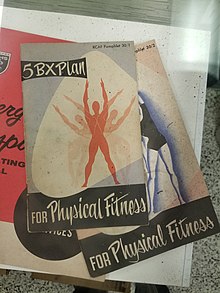
Aerobics is a form of physical exercise that combines rhythmic aerobic exercise with stretching and strength training routines with the goal of improving all elements of fitness. It is usually performed to music and may be practiced in a group setting led by an instructor. With the goal of preventing illness and promoting physical fitness, practitioners perform various routines. Formal aerobics classes are divided into different levels of intensity and complexity and will have five components: warm-up, cardiovascular conditioning, muscular strength and conditioning, cool-down and stretching and flexibility. Aerobics classes may allow participants to select their level of participation according to their fitness level. Many gyms offer different types of aerobic classes. Each class is designed for a certain level of experience and taught by a certified instructor with a specialty area related to their particular class.

Calisthenics or callisthenics (/ˌkælɪsˈθɛnɪks/) is a form of strength training that utilizes an individual's body weight as resistance to perform multi-joint, compound movements with little or no equipment.

Aerobic exercise is physical exercise of low to high intensity that depends primarily on the aerobic energy-generating process. "Aerobic" is defined as "relating to, involving, or requiring oxygen", and refers to the use of oxygen to meet energy demands during exercise via aerobic metabolism adequately. Aerobic exercise is performed by repeating sequences of light-to-moderate intensity activities for extended periods of time. Examples of cardiovascular or aerobic exercise are medium- to long-distance running or jogging, swimming, cycling, stair climbing and walking.

Physical fitness is a state of health and well-being and, more specifically, the ability to perform aspects of sports, occupations and daily activities. Physical fitness is generally achieved through proper nutrition, moderate-vigorous physical exercise, and sufficient rest along with a formal recovery plan.
Kenneth H. Cooper is a doctor of medicine and former Air Force lieutenant colonel from Oklahoma, who pioneered the benefits of doing aerobic exercise for maintaining and improving health. In 1966 he coined the term, and his book Aerobics was published in 1968, which emphasized a point system for improving the cardiovascular system. The popular mass market version was The New Aerobics (ISBN 0-553-26874-0), published ten years later.

Denise Austin is an American fitness instructor, author, and columnist, and a former member of the President's Council on Physical Fitness and Sports.

Canadian Forces Base Cold Lake, abbreviated as CFB Cold Lake, is a Canadian Forces Base in the City of Cold Lake, Alberta.
Circuit training is a form of body conditioning that involves endurance training, resistance training, high-intensity aerobics, and exercises performed in a circuit, similar to high-intensity interval training. It targets strength building and muscular endurance. An exercise "circuit" is one completion of all set exercises in the program. When one circuit is completed, one begins the first exercise again for the next circuit. Traditionally, the time between exercises in circuit training is short and often with rapid movement to the next exercise.

The following outline is provided as an overview of and topical guide to exercise:

William Robert Orban was a Canadian public servant and academic. He was a "pioneer" in the field of physical fitness, best known for creating the 5BX and XBX programmes in the late 1950s.

CrossFit is a branded fitness regime that involves constantly varied functional movements performed at high intensity. The method was developed by Greg Glassman, who founded CrossFit with Lauren Jenai in 2000, with CrossFit its registered trademark. The company forms what has been described as the biggest fitness chain in the world, with around 12,000 affiliated gyms in over 150 countries as of 2022, under half of which are located in the United States.
A fitness boot camp is a type of group physical training program that may be conducted by gyms, personal trainers or other organizations. These programs are designed to build strength and fitness through a variety of types of exercise. The activities and format may be loosely modeled on aspects of fitness training used in the military and the trainers themselves may be former military personnel.
In Australia, calisthenics is a team-based competitive performing art taking elements of rhythmic gymnastics and ballet combined with a strong emphasis on theatricality, costume, dance and musical interpretation. Since the 1950s Calisthenics has been an entirely female art form, however males have recently been re-introduced in the younger age groups. The art form was created entirely in Australia and can be easily differentiated from traditional calisthenics by its focus on competition and choreographed theatrical performance instead of simple synchronized exercise. The word itself comes from the Greek words for beauty and strength. Calisthenics is currently practiced in all states except Tasmania and has recently been introduced in New Zealand.

Wii Fit U is an exergaming video game developed by Nintendo for the Wii U console, and is the successor to the Wii games Wii Fit and Wii Fit Plus. Wii Fit U utilizes both the Wii Balance Board and the Wii U GamePad in gameplay, and is bundled with the newly introduced Fit Meter, an activity meter accessory. It was released in Japan on October 31, 2013, followed by North America and Europe one day later. It is also the only game on the system to support the balance board.

Fitness culture is a sociocultural phenomenon surrounding exercise and physical fitness. It is usually associated with gym culture, as doing physical exercises in locations such as gyms, wellness centres and health clubs is a popular activity. An international survey found that more than 27% of world total adult population attends fitness centres, and that 61% of regular exercisers are currently doing "gym-type" activities. Getting and maintaining physical fitness has been shown to benefit individuals' inner and outer health. Fitness culture has become highly promoted through modern technology and from the rising popularity of social media platforms.
John Kearns Tett, & was a Canadian athlete, wartime military pilot, physical fitness educator, and public servant. In the 1950s, he fathered the 5BX fitness program developed for the Royal Canadian Air Force (RCAF). The Tett Centre for Creativity and Learning in Kingston, Ontario is named after him.

Outdoor fitness consists of exercise undertaken outside a building for the purpose of improving physical fitness. It contrasts with exercise undertaken inside a gym or health club for the same purpose. The activity may be undertaken in a park, in the wilderness, or other outdoor location. The popularity of outdoor fitness grew rapidly in the second-half of the twentieth century and grew as a commercial consumer market in the twenty-first century.

The 20th century saw multiple trends and changes in women's fitness culture.
Xbx or variation may refer to:

Jacki Sorensen is the American originator of aerobic dancing, popularly known as aerobics. Inspired by Dr. Kenneth H. Cooper's 1968 book on aerobic exercise, she created for women an aerobic dance routine to music in 1969 in Puerto Rico, teaching U.S. Air Force wives. She expanded this concept into a teaching method and studio franchise, Aerobic Dancing Inc., that rose to 1,500 locations and 4,000 instructors teaching 170,000 students in 1981 at its peak.














